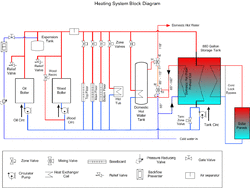Apologies if the answer to this inquiry already exists, but I have limited hi-speed Internet access at work, and only lo speed at home. My ability to conduct long Internet searches is severely limited.
I am looking for a layman's (or equivalent) schematic of the piping, devices and controls for a 2 boiler (wood and oil) hot water system connected in parallel. I have this combination but I think I am missing a basic component, or something is not set correctly, or something is not working properly. My oil burner cycles on even when the wood boiler is at temp and the boiler loop circulator is running (supposedly moving water through both boilers). This happens when there is heat demand and when there is no heat demand. There is the standard Honeywell L4148 aquastat on the oil boiler to control hi temp, circulators, and burner firing. There is an overheat aquastat which starts a circulator and opens the relief loop zone valve.
Rather than go into more detail, best for me to answer clarification questions based on a mutual model (schematic).
The goal is to solve the problem of unnecessary and unwanted oil burner operation when wood boiler is at or near operating temperature.
Thanks.



